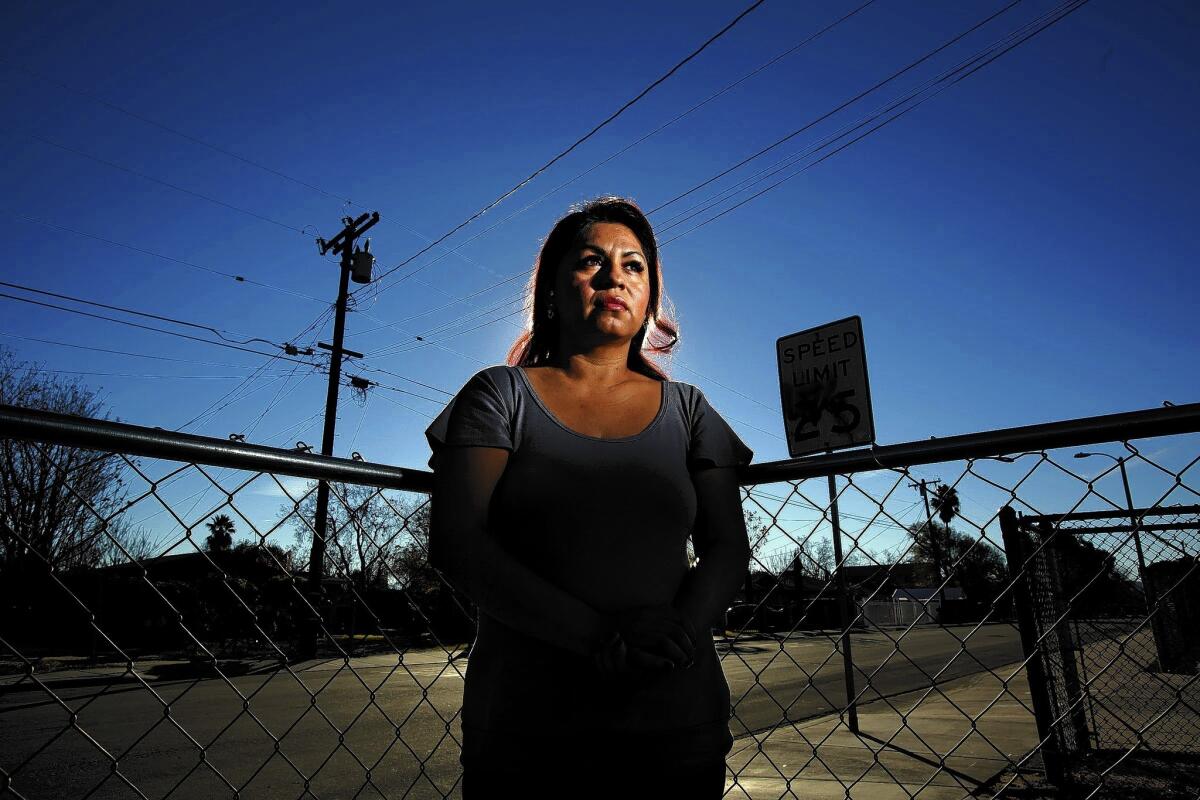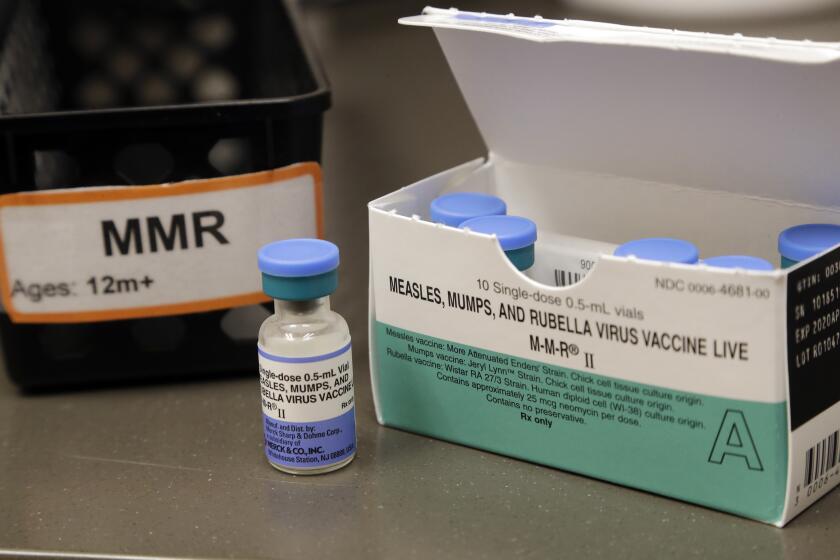Immigrants without legal status remain mostly in healthcare limbo

- Share via
When Alva Alvarez gets sick, she buys over-the-counter medicine from the grocery and takes as much as she can until she feels better. The mother of five resorts to this because she can’t afford a visit to the doctor to figure out what’s ailing her.
Although scenarios like this are supposed to disappear as millions of Americans become newly insured under the national healthcare law, Alvarez’s situation isn’t likely to improve and could get worse. The San Bernardino resident represents the biggest — and mostly invisible — group of people left out of the Affordable Care Act: immigrants in the country illegally.
Concerned by this, state Sen. Ricardo Lara (D-Bell Gardens) proposed Jan. 10 that such immigrants be allowed to get health insurance through a program such as Medi-Cal.
The new healthcare law increases the number of people who can join Medi-Cal, the state’s low-income health plan, and requires nearly everyone else to buy insurance. But those in the country illegally aren’t eligible for either, which leaves Lara and other advocates worried about the success of universal healthcare if that group’s options for coverage decrease as legal residents’ options increase.
“It’s a lot harder to steer a boat if there are people hanging off the sides,” said Anthony Wright, executive director of advocacy group Health Access California.
Typically, people without health insurance have relied on a mix of publicly supported community and free clinics, emergency rooms and county health systems. But as more and more people become insured under the new law, the vastly different ways that California counties have served patients without legal immigration status is prompting concern that large numbers of residents will fall through the cracks.
In San Bernardino County, where Alvarez lives, the government doesn’t offer regular health services to immigrants here illegally. If she were to move 12 miles south to Riverside County or half an hour’s drive west to Los Angeles County, she would qualify for free county-provided medical care.
That already uneven patchwork could intensify as clinics, hospitals and counties see huge changes in demand and funding because of the Affordable Care Act. Citing financial constraints because of the healthcare overhaul, Fresno County has been trying to stop providing for immigrants without legal status since late last year. And as the effects of the new law continue to play out across the state, it’s unclear if any pieces of the healthcare safety net will exist for those immigrants.
The California and Welfare Institutions Code requires that counties be providers of last resort, that they “relieve and support all incompetent, poor, indigent persons, and those incapacitated by age, disease, or accident, lawfully resident therein.”
To fulfill this obligation, counties typically pay for basic health services, such as a yearly checkup or emergency room costs, for their poorest residents. However, the vagueness of that mandate — paid for with a combination of state and county money — has caused leaders of the state’s 58 counties to disagree over whom they must cover and to what degree.
Some counties offer free or low-cost healthcare to all patients with incomes up to three times the poverty level. Others provide care only for those at or below the poverty level, currently set at an annual income of $15,500 for a two-person household. Some counties require that patients have a medical emergency before they can get care. Some provide for immigrants without documentation, others — such as San Bernardino, San Diego and Orange — don’t.
The law doesn’t explicitly require counties to include the state’s 2.8 million immigrants who lack legal status.
If they’re not in a county-run program, those in the country illegally can be treated for dire conditions at an emergency room or see doctors at free or community clinics in their area. However, access to these facilities and the cost also vary greatly across the state. And unlike most county programs, a clinic doesn’t typically provide preventive care, allow access to specialists or help pay for medicines.
Alvarez, 34, says that though she’s healthy now, she fears that never seeing a doctor could have consequences later. “Sometimes you don’t get diagnosed soon enough,” she said.
Currently, 11 counties in California include residents without documentation in their healthcare programs. That number, however, could drop as counties adapt to their biggest funding change in 20 years, set into motion by the Affordable Care Act.
State officials anticipate that starting this year, counties will have dramatically fewer people to cover as they shift to Medi-Cal and buy insurance through the Covered California marketplace. To adjust, the state is taking back a total of $300 million from counties’ health services budget — an average of 60% from each county — in the 2013-14 fiscal year.
Some see this as a moment of opportunity. The California Endowment, a private foundation that supports affordable healthcare, launched radio ads in December to raise awareness about people who don’t have healthcare under the Affordable Care Act. The ads, which feature an immigrant who is here illegally, are part of a $10-million campaign and will play through March in Los Angeles, Sacramento, Monterey and Kern counties.
Though the advertisement appears to encourage governments to reconsider who they cover, counties are reluctant to broaden their systems in a year when they’ll see healthcare budgets slashed by millions.
Ron Boatman, who runs San Bernardino County’s indigent care program, said immigrants without legal status will still not be covered this year and there are no plans to shrink, or expand, services in any other way.
Fresno County officials are considering barring such immigrants from its program. Caring for these roughly 5,000 people would cost the county $25 million, they said, and the county is getting only $18 million from the state compared with $32 million last year.
Henry Perea, chairman of the county Board of Supervisors, said he feels the county has a moral obligation to care for the immigrants — vital to the area’s agriculture industry.
“I don’t think we can ask them to do all that they do, and provide us the food that we eat, and turn our back on them when they get sick,” he said. “That still doesn’t mean I have an answer for where the money will come from.”
Experts predict that even five years from now, between 3 million and 4 million Californians, a quarter of whom will be without legal status, will still not have health insurance.
In the past, cash-strapped counties have cut services to such immigrants to save money. In 2009, Sacramento and Yolo counties stopped providing nonemergency services to them, and Contra Costa County suspended care for adults without legal status, saving $2.4 million, $1.2 million and $6 million respectively.
Counties like Los Angeles that include those immigrants in their health programs espouse the idea that offering preventive and primary care to them actually decreases costs in the long run by averting pricey emergency room visits.
Dylan Roby at the UCLA Center for Health Policy Research said that although providing early care has been shown to save money overall, counties would have to pay for more frequent doctor visits and prescriptions up front. And with this year’s new financial situation, he said, they would be “very reluctant to bite the bullet.”
soumya.karlamangla@latimes.com
More to Read
Sign up for Essential California
The most important California stories and recommendations in your inbox every morning.
You may occasionally receive promotional content from the Los Angeles Times.











